If you own a lakefront property or manage acreage near water, chances are you’ve encountered unique challenges when it comes to keeping your grass and aquatic vegetation under control. Enter the concept of the pontoon boat lawn mower — combining the stability and utility of a pontoon boat with specialized mowing capability to tackle vegetation in shallow water, shorelines, and floating islands of weeds. In this blog post we explore what the pontoon boat lawn mower means, how it works, why it is increasingly relevant, the benefits and limitations, and how you can choose and maintain one for your property.
What Is a Pontoon Boat Lawn Mower?
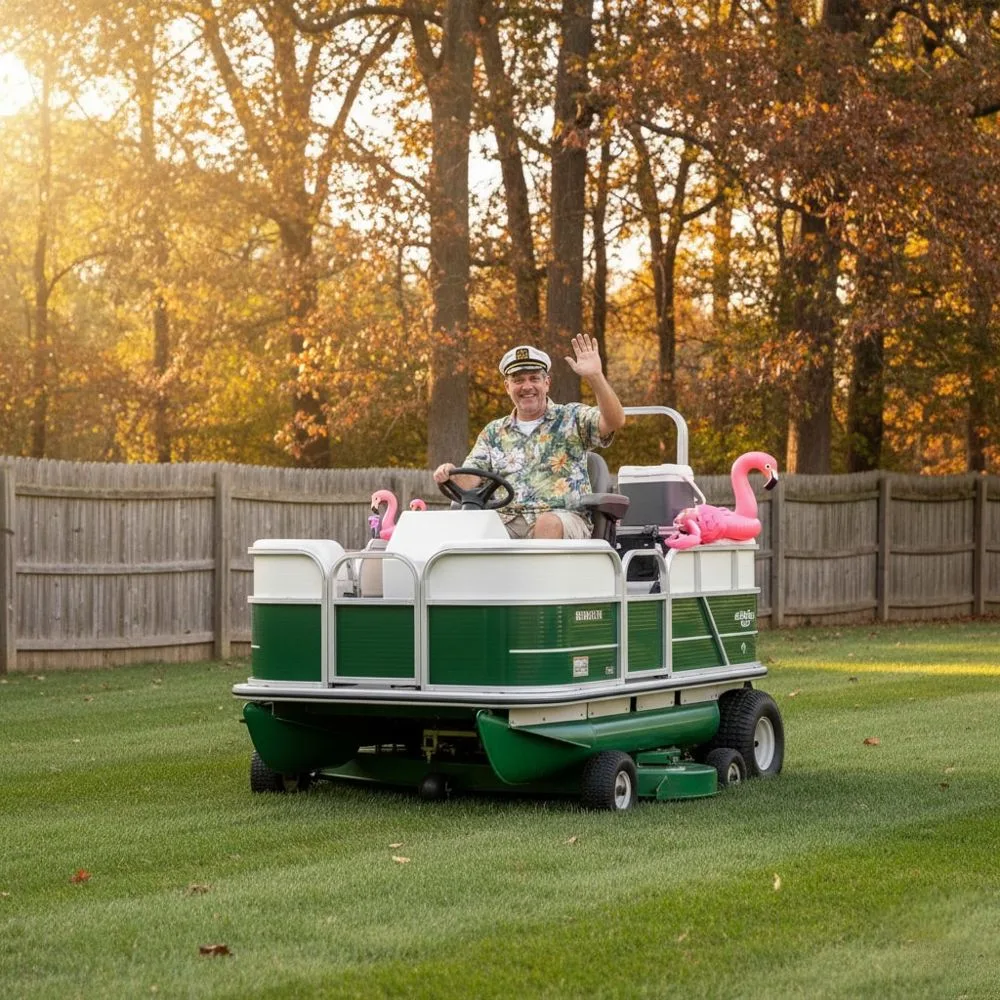
Defining the Concept
A “pontoon boat lawn mower” refers to a craft built on a pontoon hull (or twin/tri-hull floats) outfitted with a mowing or cutting mechanism designed to operate in difficult littoral zones, shorelines or aquatic areas where conventional mowers cannot go. It may be used to cut emergent vegetation, floating weeds, shallow water grasses, or even turf near the water’s edge.
The underlying hull design draws from the standard Pontoon boat — a flat deck over twin or triple floats which provides stability, shallow draft and a broad working platform. Add to that a specialized cutting deck, conveyor or rake design and you have a hybrid between a work boat and a mowing machine.
Why Use a Pontoon Platform?
Pontoon‐style hulls are particularly suited for shallow and calm water environments, offering a low draft and stable platform. Because they distribute weight across two or more floats, they can accommodate heavy equipment (like grass cutting decks, conveyors or weed harvester modules) without sinking too deep. Traditional boat hulls might struggle or damage the environment in shallow zones; the pontoon design mitigates such risk.
Typical Uses and Applications
- Cutting aquatic vegetation such as reeds, cattails, floating weeds in lakeshores, ponds or slow moving rivers.
- Mowing turf or grass adjacent to water or on floating mats or islands where access is limited.
- Maintaining large lawn areas near lakes by using a floating mower to reach near-shore zones or unstable ground.
- Commercial or municipal use: upkeep of water surfaces, floating trash and aquatic plant removal using specialized pontoon mowing boats.
Why the Pontoon Boat Lawn Mower Is Gaining Traction
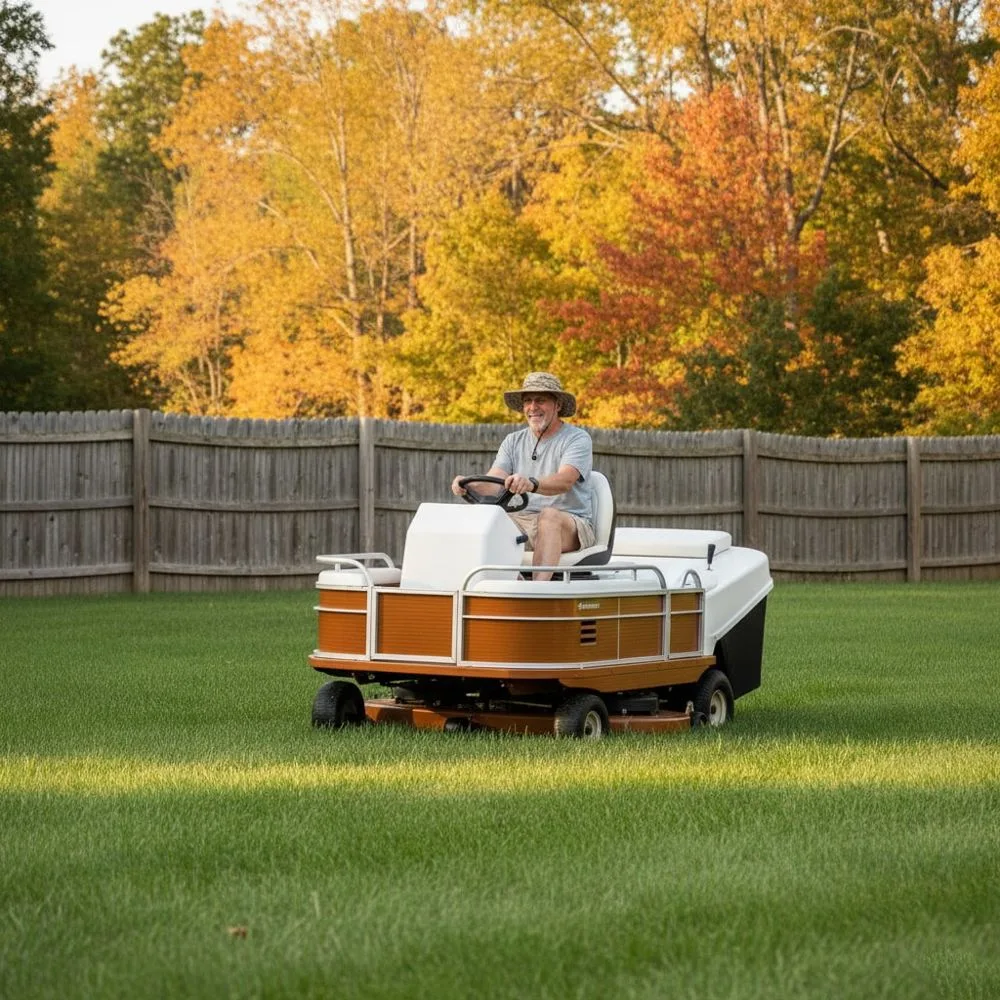
Increased Waterfront Development
As more homes and properties are built near lakes, rivers and other bodies of water, the need for specialized equipment that can safely access and maintain shoreline vegetation increases. Traditional lawn mowers simply cannot maneuver across water or soft ground, or handle floating debris or mats of weeds. A pontoon‐based mower fills that niche.
Environmental and Regulatory Drivers
Many regions now regulate shoreline vegetation, require removal of invasive aquatic plants, and demand best practices for maintaining lake health. A dedicated pontoon mower allows property managers to address those needs directly, by cutting, collecting or transporting aquatic plant material without requiring heavy land‐based equipment. Manufacturers such as Berky GmbH specialize in mowing boats and aquatic weed harvesters.
Versatility and Access
Unlike a land mower, a pontoon‐based mower can access shallow water, wet ground near the shore, or floating islands of vegetation. It can work where tractors or riding mowers cannot go without sinking or damaging turf or banks. This access gives property owners flexibility and control over otherwise tricky zones.
Evaluating the Benefits
Broad Working Range
With a pontoon base you can mow grass, tidal vegetation, shoreline plants, and emergent weeds in one machine rather than switching between land and boat equipment. It reduces the downtime of transitions and simplifies maintenance schedules.
Stability and Load Capacity
The pontoon hull offers a stable work platform that can carry heavier decks, conveyors or cutting modules. This means more efficient cutting and collection rather than piecemeal trimming.
Reduced Soil and Bank Disturbance
Since the machine floats or operates at minimal draft, there is less soil compaction and bank erosion when compared with heavy land machines placed at the water’s edge. This helps preserve the shoreline vegetation and prevent damage to turf or natural buffers.
Professional Appearance and Property Value
From a homeowner or property management perspective, having the ability to show a neat, well‐controlled lakeshore enhances the aesthetic value of the property and may contribute to higher perceived value. A pontoon boat lawn mower lends a professional level of upkeep.
Recognizing the Limitations and Considerations
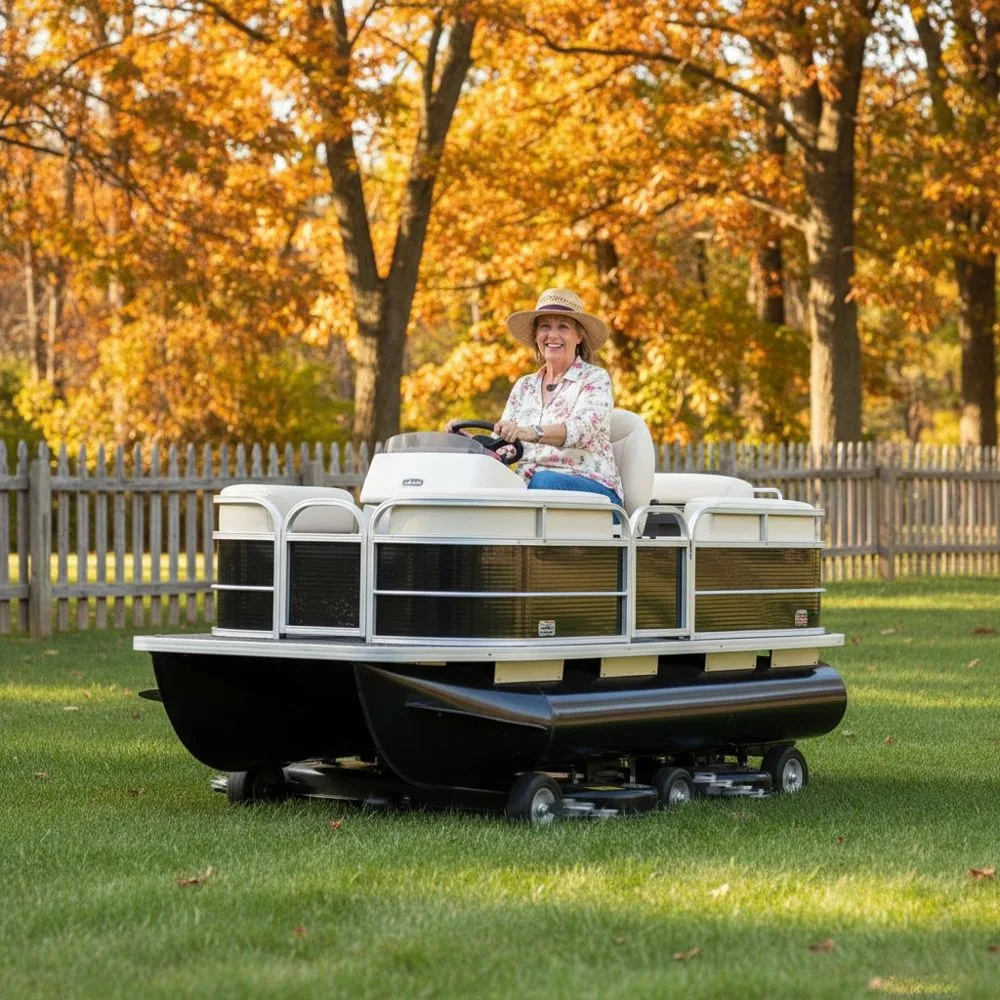
Cost and Complexity
Specialized pontoon mowing equipment often comes at a premium cost. The hull, mowing module, conveyor and operator station add complexity compared with a standard riding mower. Additionally maintenance and servicing may require expertise. For example, a floating grass mower boat listed on industrial supplier portals shows high purchase cost and specification complexity.
Environmental Permits and Regulations
Working bodies of water may have strict rules about cutting vegetation, harvesting aquatic plants, disturbing banks, or disposing of material. Owners must ensure they comply with local rules for shoreline management and aquatic vegetation removal.
Operational Constraints
Shallow water depth is still required; pontoons may still draw more water than ultra‐flat floating mats. Floating vegetation or debris can clog blades or conveyors. Wind, waves or heavy current may hamper performance. Also, access to launch, trailer and maintain the equipment must be considered.
Maintenance and Skill Requirements
Operating a pontoon mowing system may require more operator skill than a basic land mower. Often multiple controls (steering, hydraulics, conveyors) must be managed safely. Maintenance of the floating hull, gearboxes, blades, anti‐corrosion treatment, and water‐specific challenges like algae or rust must be planned.
How to Choose the Right Pontoon Boat Lawn Mower for Your Property
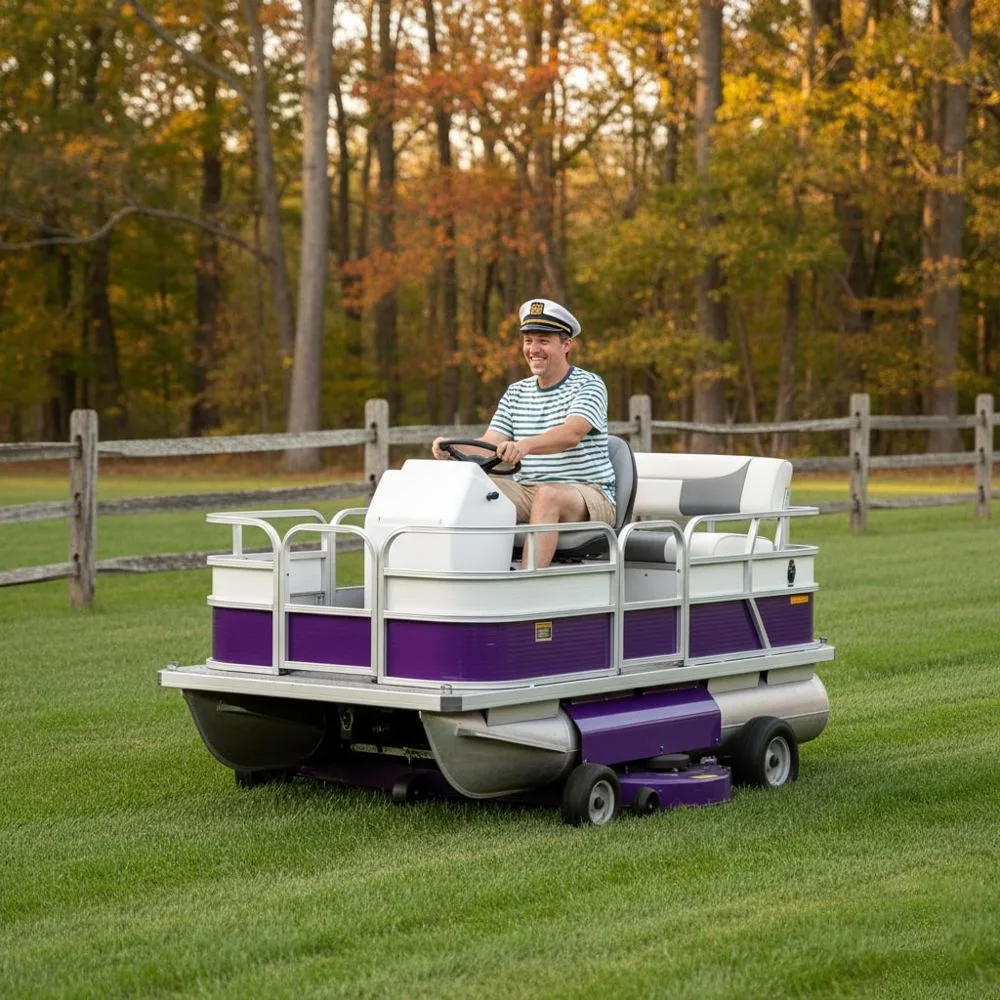
Assessing Your Site Conditions
- Water depth: Ensure the floatation and draw of the hull is compatible with your shallowest working area.
- Vegetation type: Are you mowing turf adjacent to water, emergent plants, floating weeds or aquatic grass? The cutting system must match the task.
- Shoreline conditions: Gentle sloped banks, steep banks or soft ground will affect how you launch, operate and retrieve the machine.
- Launch and transport: Do you have a trailer, ramp, or driveway to launch the pontoon machine? Consider space for storage and maintenance.
- Budget: Set realistic budget expectations for initial cost, optional modules and ongoing maintenance.
Key Features to Evaluate
- Hull design: twin‐pontoon vs tri‐toon vs single hull with floats.
- Drive system: Outboard motor versus hydraulic drive.
- Cutting deck: Front mounted or side mounted, width of cut, ability to mow at shallow depth or float over mats.
- Collection/transport mechanism: Does the machine collect cut vegetation for removal, or simply cut and drip?
- Operator controls and safety features: Start/stop, emergency shut off, hull stability, adverse conditions handling.
- Corrosion protection: Since this will be used near water and likely in a harsh environment, anti‐corrosion paint and stainless or marine grade components matter. Example: a unit designed for aquatic grass harvesting noted steel plate hull, anti‐rust marine paint, hydraulic system sealed for environmental protection.
Budgeting and Lifecycle Costs
Be sure to factor in:
- Fuel or power (diesel, petrol, electric)
- Hydraulic fluid, gear oil, bearings
- Anti‐corrosion treatment and hull maintenance
- Spare parts for blades, conveyors, floats
- Launching/trailer costs and seasonal storage
- Operator labor or training
Operational Best Practices and Safety Tips
Pre-Operation Checklist
- Inspect hull, flotation tubes, seams, and anti‐corrosion coats
- Check drive motor, belts, hydraulic systems, filters
- Verify cutting deck blades are sharp and secure
- Ensure operator controls function and emergency shutoff works
- Check water depth and current conditions; avoid strong flow or high winds
- Confirm disposal plan for cut vegetation and check local regulations
Safe Operation Tips
- Do not overload the deck or floats; maintain stability
- Approaching shorelines or mats slowly; avoid abrupt turns or bank damage
- Use appropriate speed when cutting floating mats — too fast may cause wave action that destabilizes the hull
- Monitor fuel levels, oil temperature, and hydraulic pressure
- Avoid operation near swimmers, shallow obstacles or submerged hazards
- When collecting vegetation, ensure proper securing to prevent spillage
Maintenance and Aftercare
- Rinse hull and components after operation in brackish or dirty water
- Flush out hydraulic lines and motor cooling systems if used in debris-rich water
- Sharpen or replace blades regularly; inspect conveyors for wear
- Check pontoon tubes for sealing and buoyancy performance yearly
- Store equipment under cover, out of water, if possible when not in use
Case Scenarios: Practical Uses of the Pontoon Boat Lawn Mower

Lakefront Homeowner
Imagine a homeowner with 300 ft of shoreline where grass meets the lake and floating mats of weeds collect along the bank. A pontoon boat lawn mower allows the owner to cut from the water side, trim the bank, and reach floating vegetation that traditional mowers cannot touch. It avoids driving heavy machinery on sensitive shoreline turf, preserving the grass and preventing soil compaction. The result is a clean lawn line, healthy lake edge and easier upkeep.
Municipal or Resort Groundskeeping
A resort with multiple docks, floating docks and lakefront cabins may employ a pontoon mowing craft to maintain vegetation around docks, swim zones and shallow bays. The craft can collect emergent weed mats, maintain clean shorelines for guests, and comply with environmental regulations. It becomes part of a professional groundskeeping fleet rather than patchwork solutions using land mowers and separate aquatic weed cutters.
Environmental or Commercial Maintenance Company
Companies specializing in aquatic vegetation removal may use pontoon mowing boats equipped with conveyors and collection bins. These services offer to clean lakes, ponds or reservoirs, cut reeds or invasive aquatic plant species, and transport removed material for disposal. The pontoon hull allows access to remote zones and floating debris fields. Manufacturers of mowing boats, such as the firm Berky, highlight this specialized niche.
Frequently Asked Questions (FAQ)

Can I convert a regular pontoon boat into a lawn mower craft?
In principle yes, but it requires careful engineering. You would need to install a cutting deck or rake, ensure flotation balance, modify drive and controls, and verify regulatory compliance. It may be more cost effective to purchase or lease a purpose-built pontoon mower.
Is this just for aquatic weeds or can I mow turf from the water?
Both. Some models are designed for emergent aquatic plants and floating mats; others are capable of mowing turf near the water edge or even marshy zones where traditional mowers cannot access. The key is to select the right deck and module for your need.
Are there environmental concerns with using a pontoon mower?
Yes – you must consider disturbance of aquatic habitat, potential erosion of banks, spread of invasive species, and disposal of cut material. Many jurisdictions regulate shoreline vegetation-removal activities and you should always check local policies before operating.
What about alternative solutions?
If your lawn and shoreline is narrow and accessible by land, a conventional riding mower or zero-turn mower may suffice. For floating weeds only, aquatic weed harvesters or skimmers may be cheaper. But for combined turf plus aquatic vegetation plus shallow water access the pontoon boat lawn mower offers unique advantages.
Practical Steps To Implement on Your Property
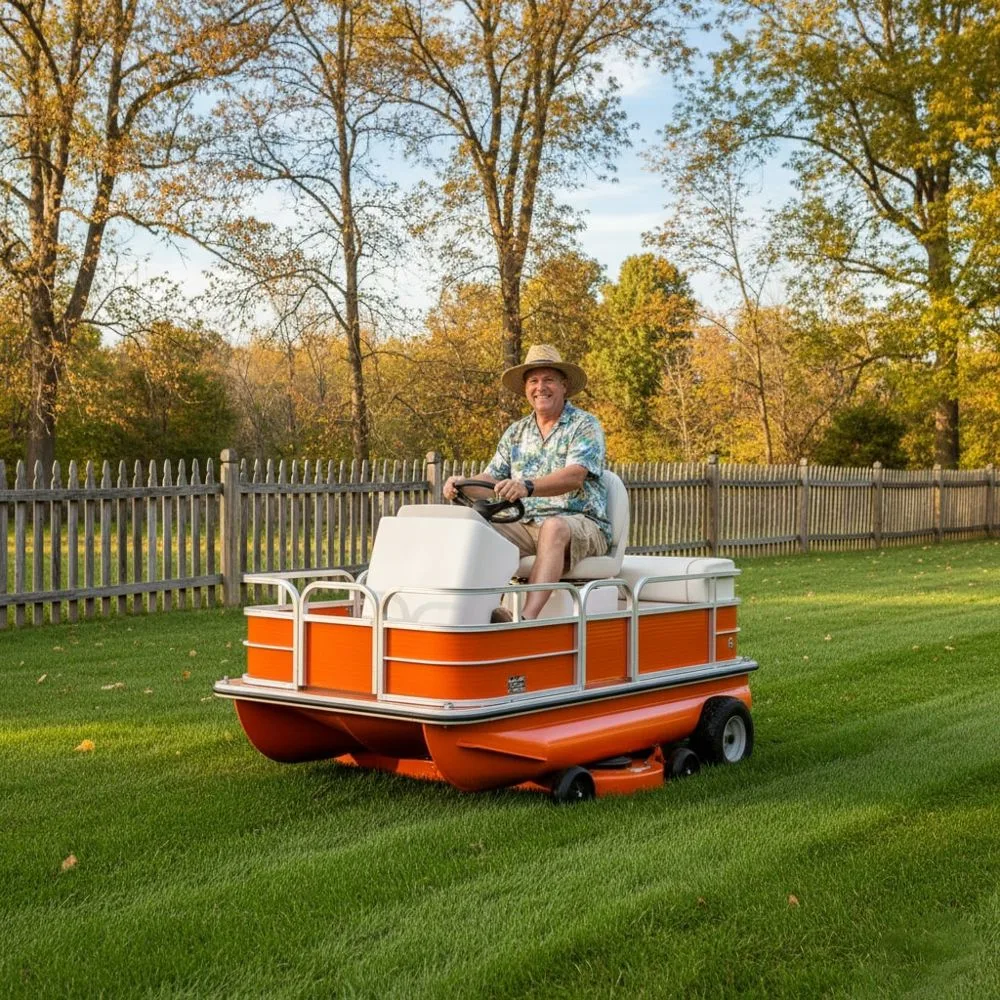
- Conduct a survey of your shoreline, depth profile, vegetation types and access points.
- Research equipment options – look for hull size, deck type, motor power, collection capacity.
- Request quotes from manufacturers or service providers who specialize in aquatic mowing/weed harvesting.
- Review local regulations for shoreline vegetation removal, aquatic plant harvesting and machine launches.
- Plan logistics: storage, maintenance, operator training, launch/haul out.
- Schedule regular maintenance, blade sharpening, hull inspection, and floatation checks.
- Monitor results: track how much vegetation is cut, how shoreline health improves, how turfs respond.
The Future of Shoreline Lawn Care and Mowing Innovation
As shoreline properties and aquatic recreation continue to expand, we will see more innovation in equipment like pontoon boat lawn mowers. Expect features like:
- Electric or hybrid propulsion for quiet and low-emission operation near sensitive lake zones
- Remote or autonomous mowing platforms for large lakes or difficult to access banks
- Modular cutting decks with interchangeable tools (weed cutter, turf mower, rake) to increase versatility
- Real-time sensors to detect depth, vegetation density and bank conditions
- Integrated debris collection bins and transport solutions for removed material
These advancements will further make the pontoon boat lawn mower concept accessible to residential and commercial users, not just heavy duty municipal or industrial users.
Ethical and Environmental Considerations
When using a pontoon boat lawn mower, it is important to treat the lakeshore environment responsibly. Avoid overcutting natural vegetation buffers that prevent erosion and support wildlife. Use equipment in a way that minimises disturbance to aquatic habitat, prevents sediment release, and does not introduce invasive species. Ensure cut vegetation is disposed of properly and not simply left to float. By working in an eco-aware way you protect the environment, preserve shoreline health and maintain the long-term value of your property.
Conclusion: Bringing It All Together
The pontoon boat lawn mower presents a compelling solution for lakeside and waterfront property owners who face complex mowing challenges. By combining the versatility of a pontoon hull with specialized cutting modules, this hybrid machine bridges the gap between land mowers and aquatic weed harvesters. Properly selected and operated, it delivers efficient shoreline maintenance, reduces damage to sensitive banks, and enhances property aesthetics.
Whether you own a secluded lakeside retreat, manage resort grounds, or operate a shoreline maintenance business, embracing this innovative approach to mowing can elevate your game. Start with assessing your site conditions, researching equipment options, factoring in maintenance and regulatory constraints, and always keep the environment in mind.
In short: if you’ve been battling inaccessible turf, floating weeds or tricky shorelines, it might be time to consider a pontoon boat lawn mower—and transform your lake edge into a clean, healthy, and beautiful zone.
Wrap-Up: Harness Water Access, Cut With Precision, Maintain with Intelligence.

